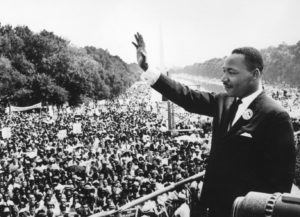
Nowadays, when people think of heroes, they probably imagine buffed-up men or women in skimpy oufits, who solve problems using a variety of superhuman abilities. But not all heroes dress in spandex or come from an alien planet. 50 years ago the world lost a hero. He was shot by a white segregationist, James Earl Ray, in Memphis, Tennessee, on April 4, 1968. His name was Martin Luther King. He was just 39 years old.
The Man
King was a leader of the civil rights movement. His role in his struggle against poverty and racial injustice in his country earned him the Nobel Peace Prize at 35. Some milestones:
– King was born in Atlanta, January 15, 1929, in the Southern state of Georgia
– ln June 18, 1953 he married Coretta Scott. They had four children.
– In December 1955, King, as Baptist pastor, led a protest boycott against racial segregation on buses in Montgomery, Alabama.
– In April 1963, he was imprisoned for participating in anti-segregation demonstrations. In his famous “Letter from a Prison in Birmingham”, he explained his peaceful struggle against racism.
– In August 28, 1963, during the March for Work and Freedom, in Washington, King delivered his now famous “I Have a Dream” speech. It was on the steps of the Lincoln Memorial, in front of about 250,000 protesters.
– In October 14, 1964, he became the youngest Nobel Peace Prize laureate, for his nonviolent resistance against racial segregation.
– In 1967, a year in which more than 11,000 American soldiers died in Vietnam, King began a campaign against it. At Riverside Church in New York, he delivered a memorable speech. As a sworn opponent of US foreign policy, he became a polarizing and controversial figure.
– King also spoke against poverty in the United States and demanded justice not only for African-Americans but for all the poor, no matter the color of their skin.
– In the last years of his life, King, a lifelong advocate of nonviolence and civil disobedience, was criticized by some African-American activists who wanted him to employ more confrontational strategies.
– Curiously, his opposition to the war was seen as “extremist” when the conflict started. In fact, King had been under constant surveillance by the FBI for years. It had labeled him the “most dangerous man in the country”.
– His death sparked outrage and riots across the nation.

The Legacy
Fifty years after his death, the dream of racial equality that King envisioned in his most famous speech remains distant. Sensitive issues like black poverty, the rate of incarceration for African-americans and police brutality are a constant reality check for King’s vision.
In spite of this, there has been progress for African-Americans over the years. For instance, the changes in individual racial attitudes that King championed for brought about the first black president, Barack Obama, who was elected in 2008.
King’s legacy has influenced movements like Black Lives Matter, against police violence and the March for Our Lives, in which millions of young people marched to demand tougher laws against guns.
Quotes
* “I have decided to stick with love. hate is too great a burden to bear”.
* “Darkness cannot drive out darkness; only light can do that. Hate cannot drive out hate; only love can do that.”
* “The ultimate measure of a man is not where he stands in moments of comfort and convenience, but where he stands at times of challenge and controversy.”
* “I have a dream that one day on the red hills of Georgia, the sons of former slaves and the sons of former slave owners will be able to sit together at the table of brotherhood.”

* “Love is the only force capable of transforming an enemy into a friend.”
* “History will have to record that the greatest tragedy of this period of social transition was not the strident clamor of the bad people, but the appalling silence of the good people.”
* “Life’s most persistent and urgent question is, ‘What are you doing for others?’”
Martin Luther King’s work is celebrated with a national holiday, on the third Monday in January each year, and a granite monument in Washington. The place of his death, the Hotel Lorraine, is now the National Civil Rights Museum.
